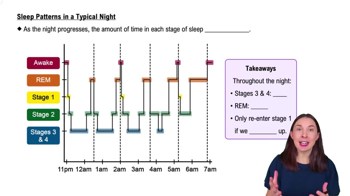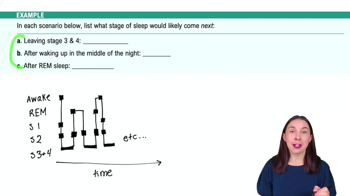Table of contents
- 1. Introduction to Psychology1h 43m
- 2. Psychology Research2h 20m
- 3. Biological Psychology2h 41m
- 4. Sensation and Perception28m
- 5. Consciousness and Sleep32m
- 6. Learning41m
- 7. Memory34m
- 8. Cognition37m
- 9. Emotion and Motivation35m
- 10. Developmental Psychology33m
- 11. Personality48m
- 12. Social Psychology41m
- 13. Stress and Health41m
- 14. Psychological Disorders44m
- 15. Treatment47m
5. Consciousness and Sleep
Sleep
Struggling with Psychology?
Join thousands of students who trust us to help them ace their exams!Watch the first videoMultiple Choice
Freud used dreams as a way to get at patients'
A
phobias.
B
unconscious conflicts stemming from childhood.
C
susceptibility to psychoanalysis.
D
brain waves.
 Verified step by step guidance
Verified step by step guidance1
Understand that Sigmund Freud, a prominent figure in psychology, believed that dreams were a window into the unconscious mind.
Recognize that Freud's theory of psychoanalysis posits that many psychological issues stem from unresolved unconscious conflicts, often originating in childhood.
Identify that Freud used dream analysis as a technique to uncover these unconscious conflicts, which he believed were expressed symbolically in dreams.
Acknowledge that Freud's approach to understanding phobias involved exploring these unconscious conflicts through methods like free association and dream interpretation.
Note that Freud's focus was not on brain waves or physiological aspects of dreaming, but rather on the symbolic and psychological meanings of dreams as they relate to unconscious conflicts.

 3:25m
3:25mWatch next
Master Circadian Rhythms with a bite sized video explanation from Hannah Gordils
Start learningRelated Videos
Related Practice


































































































![Race, Genes and IQ Differences | Bret Weinstein [Mini Clip]](https://img.youtube.com/vi/IztL_m3pd70/mqdefault.jpg)



































































































